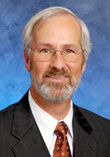Sep. 30, 2014
 The ASRT Foundation caught up with Spencer Sias, Vice President, Corporate Communications and Investor Relations of Varian Medical Systems. Spencer manages investor relations and corporate communications including public relations, employee communications and community relations for the company.
The ASRT Foundation caught up with Spencer Sias, Vice President, Corporate Communications and Investor Relations of Varian Medical Systems. Spencer manages investor relations and corporate communications including public relations, employee communications and community relations for the company.
ASRT Foundation: What are some of Varian's initiatives that make you proudest?
Spencer: I am proud to be working for a company whose goal is to save 100,000 more lives each year. Over the last decade, we have introduced many innovations that have the potential to enhance the effectiveness of radiotherapy and radiosurgery in the fight against cancer.
ASRT Foundation: What do you wish people knew about Varian? What message do you want to make sure viewers understand?
Spencer: We want to make it clear that Varian is committed to saving lives and that we are truly a partner for life. We work with clinicians to make sure that we are developing and deploying significant advances for radiation oncology. Technology like intensity-modulated radiation therapy, image-guided radiation therapy, stereotactic radiosurgery and proton therapy are contributing to improved patient survival rates and lower complications.
ASRT Foundation: What is one of your favorite patient stories?
Spencer: I really like the story of Odette Pringle. It's on our website:
Odette Pringle had learned to tolerate her headaches but when her vision began to blur, she promptly went to see a doctor. A new pair of reading glasses didn't seem to help, and before long, her eyesight grew so cloudy that the world around her was in a constant shade of grey. She went to a different ophthalmologist, who thought the problem might be due to cancer. Following a magnetic resonance imaging procedure, it was soon discovered that Odette had a benign brain tumor growing out of her pituitary stalk and pressing on her optic nerves. About 80 percent of the growth was removed surgically and the remainder was treated with RapidArc radiation therapy five days a week for nearly six weeks.
"It's common to hear the words 'brain tumor' and 'radiation' and start to panic," said Odette, 47. "But compared with the after effects of surgery, radiation treatment was actually fairly painless."
She added, "I have a seven–year-old daughter and was busy watching her while I was undergoing treatments. I'm grateful that I felt well enough to still be a mom."
Odette lives in Colorado but decided to have the tumor treated in Los Angeles. She and her daughter took temporary residence nearby as she was treated at the Center for Radiation Therapy of Beverly Hills on a Varian linear accelerator machine equipped with RapidArc radiotherapy technology. For patients, the most evident advantage of RapidArc is how quickly it enables the treatment to be delivered.
"As I would lie still on the treatment table each day, watching the machine rotate around me, I'd often listen to jazz, or some other kind of music I had asked for," said Odette. "I was surprised that within two to three minutes the treatment sessions were complete. Sometimes it may have taken a few minutes longer to setup, but that was it. I thought the treatments would've taken longer."
Odette's brain tumor had been growing intermittently since birth but had begun to press on her optic chiasm and compromise her vision. The headaches that she had endured most of her life were also attributed to the brain tumor. Only a few weeks into her treatments, Odette's vision returned to normal and the headaches began to subside.
"My overall experience was rough at times, but receiving radiotherapy wasn't bad at all. I tried to make the most of it with my daughter by going to movies, riding bikes at the beach and visiting friends each day when my sessions were through. It's been important to stay positive for myself and my family."
ASRT Foundation: What advice do you have for companies who have considered supporting the Foundation but have not as yet?
Spencer: ASRT's mission is to advance the medical imaging and radiation therapy profession and to enhance the quality of patient care. We all have a responsibility to support an organization that provides resources to radiologic technologists and the need to improve patient care.